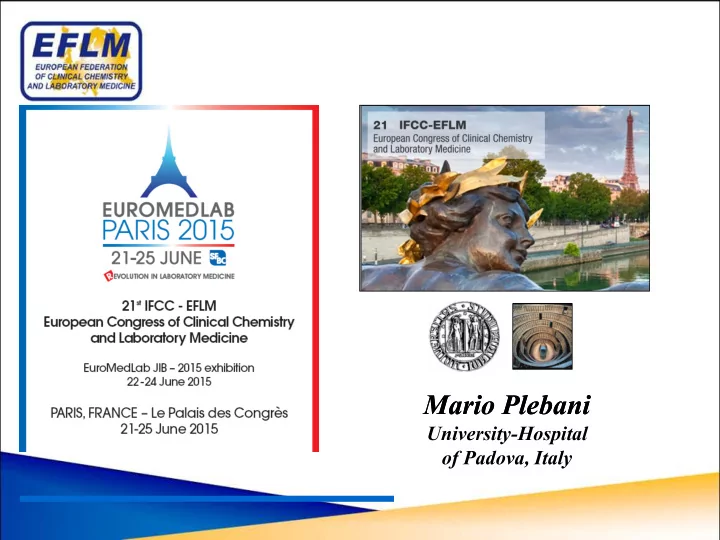

Mario Plebani Mario Plebani University-Hospital of Padova, Italy
Quality in laboratory medicine should be defined as the guarantee that each and every step in the total testing process is correctly performed, thus ensuring valuable decision making and effective patient care . Plebani M. Clin Biochem Rev 2012
Right test, for the right patient Pre-analytical Right time for specimen collection Right specimen and processing Right test result generated Analytical Right test result reported, Post-analytical acknowledged and interpreted “ Wrongs ” anywhere compromise test result quality and patients ’ safety ! 3
ACTION Physician Physician ysician ’ ysician ’ s Ordering Interpretation Bra Bra rain rain Collection Reporting Identification Analysis Transportation Preparation
• Evidence has been collected on the frequency and stratification of errors in laboratory medicine. • The vulnerability of both the pre-analytical phase , which accounts for approximately 70% of laboratory errors, and of the post-analytical phase has been highlighted as well as the risk for quality and patient safety. • Consensually defined criteria for setting extra-analytical quality indicators have been developed and data collected. • This in turn, should provide the way to define reliable performance criteria in the pre-and post-analytic phases.
ACTION ACTION Post Post- Post Post-analytical analytical Ordering Physi Physician ian ’ s Interpretation Interpretation Br Brain Br Brain in in phase phase Pre Pre- Post Post-analytical analytical Collection pre pre-analytical analytical phase phase Reporting Reporting LAB LAB LAB LAB phase phase Identification Analytical Analysis Analysis phase Transportation Preparation The highest frequency of Less prone to errors errors with high risk Pre-analytical compared with processes for patients performed outside the lab phase
Sandberg S et al CCLM 2015
Analytical Phase Pre/Post-Analytical Phase Hierarchy of criteria Well defined Not defined Possibly based on the State-of-the-Art and on Outcome Measures Quality Specifications Well defined Under development Bias and Reproducibility Metrics Well defined Proposed - Percentage - Parts per million (ppm) - Six sigma Tools of measures Well defined Recently defined - Internal Quality Control (IQC) Quality indicators (QI) - External Quality Assessment (EQA)
-Harmonization Harmonization - Work in progress Work in progress -Metric Metric -Performance specifications Performance specifications
Key Processes Priority Priority 1 1 2 2 3 3 4 4 Pre-analytical phase 22 22 2 2 2 2 2 2 Intra Intra- -analytical phase analytical phase 5 5 0 0 1 1 0 0 Post-analytical phase 8 8 0 0 0 0 3 3
Range Median Specifications 2.0 Optimum Specimen not received 2.0 - 6.1 2.9 4.0 Desirable 6.0 Minimum 0.07 Optimum Specimen insufficient 0.07 - 0.8 0.15 0.44 Desirable 0.8 Minimum 0.02 Optimum Wrong container 0.02 - 0.2 0.03 0.11 Desirable 0.2 Minimum
Post-Analytical Processes Quality Specifications on the basis of 25 ° -50 ° - 75 ° percentile Quality Indicators Minimum Desirable Optimum Percentage 0.12 32.2 62.5 Percentage of: Number of reports with interpretative comments impacting positively on patient's outcome/ Total number of reports with interpretative comments (Post-Comm) Sigma 1.699 1.967 4.429 Percentage 0.035 0 0 Percentage of: Number of incorrect reports issued by the laboratory / Total number of reports issued by the laboratory (Post-IncRep) Sigma 4.621 4.791 4.932 Percentage 0.13 0 0 Percentage of: Number of reports delivered outside the specified time/ Total number of reports. (Post-OutTime) Sigma 3.782 4.508 4.793
Measure Measure Causes Causes 1) Inappropriate test ordered 1) Inappropriate test ordered - Cognitive problem - Cognitive problem - Defensive medicine issues - Defensive medicine issues - Misspelt test name - Misspelt test name - Misunderstanding of physician ’ s request - Misunderstanding of physician ’ s request 2) Appropriate test not ordered - Cognitive problem 2) Appropriate test not ordered - Cognitive problem - Misspelt test name - Misspelt test name - Misunderstanding of physician ’ s request - Misunderstanding of physician ’ s request - Test lost in translation (from physician ’ s - Test lost in translation (from physician ’ s request to electronic or hard copy) request to electronic or hard copy)
Measure Causes 3) Result of appropriately ordered - Patient/sample misidentification test inaccurate - Pre-analytical errors in sample collection and handling - Instrumentation failure, analytical interference and poor analytical performances
Appropriate test ordered, but - Delayed sample collection or transportation delay in TTP occurs - Delayed analytical performance - Delayed trasmission of results - Delayed acknowlegement by care operators/ physicians Appropriate test result - Cognitive failure of clinicians misapplied - Available information incomplete - Wrong reference ranges or decision levels - No interpretative comment Outpatients called back for - Suspected patient/sample misidentification wrong procedures - Unsuitable samples - Incorrect results - Suspected interference
1) Enrollment of the members of the TFG-PSEP done 2) Project planning 3) Spread of the information 4) Collection of data 5) Proposal of preliminary performance specifications 6) Further steps
Recommend
More recommend